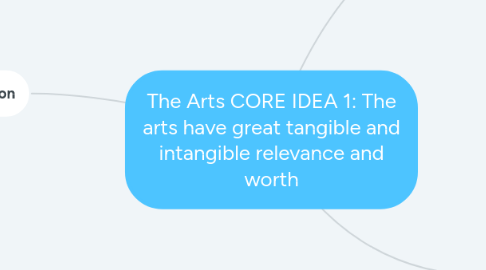
1. Education
1.1. The arts in education help to develop empathy (also a Social functions of the arts)
1.1.1. Empathy helps us to comprehend other cultures, groups or individuals and better connect with them
1.1.2. In the workplace, empathy is crucial for successful collaboration and communication as it allows individuals to see the perspective of those they are working with
1.1.3. The arts are crucial in developing empathy because many art forms encourage the viewer to take on the perspective of a distinctively different character
1.1.4. The arts in school definitely help to cultivate this trait like the A Levels subjects, Literature and Theatre Studies, in schools
1.1.5. CASE STUDY: Using forum theatre to develop empathy and to find resolutions to problems
1.2. The arts promote cognitive and creative development in individuals
1.2.1. Studies conclude that learning that takes place through the arts improves attainment across many other aspects of the school curriculum and has a wealth of other benefits...
1.2.1.1. Taking part in drama and library activities improves attainment in literacy where the former has been known to enhance verbal and communication skills
1.2.1.2. Taking part in structured music activities improves attainment in activities in mathematics, early language acquisition and early literacy
1.2.1.3. Schools that integrate the arts across their curriculum have shown consistently higher average reading and mathematics scores compared to schools that do not
1.2.1.4. Students studying music have been found to develop heightened spatial-temporal reasoning and perceptual skills
1.2.1.5. The study of literature has long been linked with the cultivation of critical thinking, in-depth analysis and the ability to consider multiple perspectives
1.2.1.6. In schools, the arts also enhance creative development because they allow students to create and improvise without having to follow rules and regulations which provides them a conducive space to be creative and think outside of the box
2. Value
2.1. Tangible - Has a material (material) presence and is therefore capable of being assigned monetary value; quantifiable and measurable (eg: economic value)
2.2. Intangible - Non-material; hard to measure (eg: social value)
3. Social/ Cultural
3.1. The arts foster community spirit
3.1.1. Community spirit is the feeling of involvement, concern and pride for one's local community
3.1.2. Distinctive and famous pieces of community art, like public murals and sculptures, can take pride to the community, and locals can use them as a marker of identity
3.1.3. The potential to develop community spirit is even greater when locals have a part to play in making the community more vibrant and conducive to live in
3.1.4. CASE STUDY: Kampung Penlangi (Rainbow Village), Semarang, Indonesia
3.2. The arts help to preserve cultural identity
3.2.1. The arts communicate unique aspects of the community's history and cultural traditions through art forms from traditional songs and dances, to clothing, and even to folklores that have been passed down which preservation can therefore help keep these aspects of culture intact
3.2.2. CASE STUDY: Museums of Singapore
3.3. The arts help to express individual identity
3.3.1. The arts also enable us to better express our individuality and emotions and in doing so, allow us to further develop our identity
3.3.2. CASE STUDY: Art Therapy through Self-Expression

